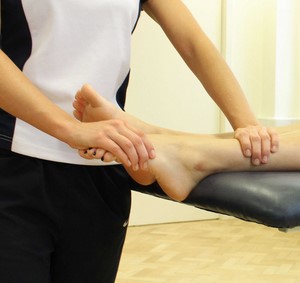Sprained Your Ankle Again?
90% cases of untreated ankle sprains can become recurring (as in the ankle keeps getting sprained again and again), but there’s good news: with skilled ankle sprain physiotherapy we can decrease the recurrence to below 40%.
Contents
What’s an ankle sprain?
An ankle sprain happens when the ankle either bends IN or OUT too much, stretching the ankle ligaments more than they’re supposed to. It’s painful, and often lead to swelling and a prolonged period of time where it’s difficult (and painful) to put weight through the injured ankle.
Sometimes it’s caused by
- slip or misstep
- during sports or activities where the body moves but the foot hadnt
- accident such as in motorvehicle
Our ankles are supported by three main ligaments:
- the anterior talofibular ligaments (ATFL)
- posterior talofibular ligaments (PTFL)
- the calcaneofibular ligament (CFL)
The most common form of ankle sprain is the inversed ankle sprain (see the image above), which happens when the foot lands awkwardly and rolls inwards, and results in lots of pain on the outer part of the ankle. The ATFL ligament is the most commonly sprained ligament because of the limitations of it structural mechanics and support.
The other type of ankle sprain is the eversion ankle sprain on the inside part of the ankle, which happens when the foot is overstretched outwards. Much more rare, but it does happens.
Multiple ankle sprains
When the ankle sprains again and again, it’s called a recurring ankle sprain, and these kinds aren’t good at all.
The multiple and repeated overstretching of ligaments causes the ligaments to slowly lose their normal
- elastic function
- elastic strength
- ability to adjust quickly on uneven surfaces
This leads to a vicious cycle where the likelihood of more ankle sprains down the road.
Grades of ankle sprains
Ligament injuries have 3 grades:
- Mild sprains usually involve very little ligament fiber tear, and its the fastest to recover because it’s milder. Pain is mild and patients tend to recover fairly rapidly with ankle sprain physiotherapy
- Moderate sprains involve more ligament fibers, and patients will observe a lot more ankle pains and instability. Pain is moderate and it’d take a lot longer and more ankle physiotherapy sessions to recover.
- Severe cases of ankle sprains can mean full ankle ligament rupture, and these typically will require reconstructive ligament surgery followed by post-surgery ankle physiotherapy.
I think I sprained my ankle – what do I do?
First, we recommend going to the accident and emergency department to consult a doctor and get an xray done. The reason for this is to make sure there’s no fractures.
Unless it’s a very, very mild ankle sprain and there’s only slight pain, then you can consider applying the RICE approach (rest, ice, compress, elevate). Go home asap, and try to not put weight through the sprained ankle. Do cold therapy on the ankle for about 15 minutes on, 15 minutes off.
If you’re using ice, please do NOT apply ice directly to skin because that cause cause ice-burns.
Do cold therapy on-off for the first 2-3 days to bring down the swelling and pain, which will prevent secondary damage in the ankle.
For the injured ankle ligaments to heal well, we recommend to immobilize and protect the injured ankle with an ankle brace. The brace needs to be snug enough to secure the ankle and protect it, but not too tight that it stops circulation ie your toes should not be tingling or turning white / blue!
Wear that during the time when you’re awake and alert, and you can remove it when you sleep. Some patients prefer to wear it when they sleep and take off the ankle brace when they’re awake, which is okay too as long as your ankle is protected. You can choose to elevate your ankle by
- placing it on a firm pillow as you sleep / lie down
- placing it on a chair if you’re seated
Do some toe and ankle pumping exercises (bringing your toes and ankle closer to your shin, hold for 5 seconds, and then all the way down away from your shin for 5 seconds), around 10x every waking hour. This helps with circulation and prevents ankle stiffening.
It’s my second ankle sprain, I dont want it to come back!

Unfortunately as I shared earlier, up to 90% of untreated ankle sprains tend to recur, and the way to bring that recurrence percentage down to below 40% is to go through ankle sprain physiotherapy treatments, whereyou may undergo
- ultrasound therapy to accelerate soft tissue healing (eg ligament, muscles, tendons)
- soft tissue management to increase (pain-free) range of motion
- swelling and edema circulation management
- retraining of proprioceptive centers in the ankle
- strengthening of tendons and muscles
- balance training
- specific trainings
Where To Next?
- Go to Home / Start
- Learn and find out more about your pains (bones, muscles, joints, tendons, ligaments, nerves etc) at Pain Conditions & Injuries
- Visit our shop to see products we recommend for pain relief, heating, treatments and more
- Contact us




